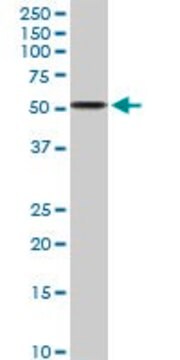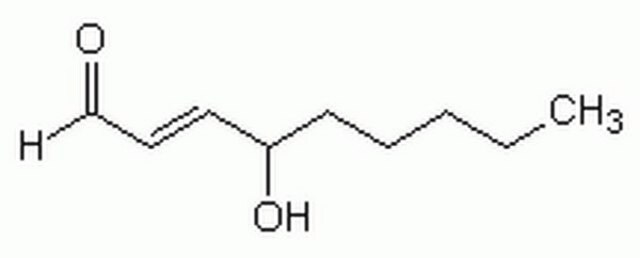ABN249
Anti-HNE Michael Adducts Antibody, Reduced
serum, from rabbit
Sinonimo/i:
Reduced 4-hydroxy-trans-2-nonenal Michael adducts, Reduced HNE Michael adducts
About This Item
Prodotti consigliati
Origine biologica
rabbit
Livello qualitativo
Forma dell’anticorpo
serum
Tipo di anticorpo
primary antibodies
Clone
polyclonal
Reattività contro le specie
bovine, human
tecniche
western blot: suitable
Condizioni di spedizione
ambient
modifica post-traduzionali bersaglio
unmodified
Descrizione generale
Specificità
Immunogeno
Applicazioni
1. ABN249 replaces Calbiochem 393207. ABN249 is expected to work in immunocytochemistry and immunohistochemistry. Please refer to the following 393207 citations as examples of sample preparations and detection in these two types of applications:
Usatyuk, P.V., et al. (2006). J. Biol. Chem. 281(46):35554-35566 (Immunocytochemistry).
McCormack, A.L., et al. (2005). J. Neurochem. 93(4):1030-1037 (Immunohistochemistry).
2. Anti-HNE Fluorophore, Cat. No. 393206, is also available for the detection of HNE Fluorophore by ELISA, Immunohistochemistry, and Western blotting.
3. To generate a positive control for Western blotting, treat a 2 mg/mL BSA solution in 10 mM KH2PO4, pH 7.4, with 0.1 to 0.5 mM HNE and incubate for 1 hr at 37°C. The reaction can be monitored by the decrease of HNE absorbance at 224 nm (extinction coefficient 13,750/M). Free HNE can be removed by gel filtration and dialysis following the chemical reaction.
HNE Michael adducts in protein solutions must be chemically reduced by sodium borohydride (NaBH4) prior to analysis using ABN1348. A freshly prepared 100 mM NaBH4 solution in 1 mM NaOH is added 1:9 (V:V) to the protein sample solution to a final NaBH4 concentration of 10 mM. The protein solution is kept at room temperature for 10 to 30 min prior to quenching with the addition of 5 to 10 molar equivalents of acetone.
Qualità
Western Blotting Analysis: A 1:10,000 of this antibody detected 10 ng of HNE-modified BSA only after, but not before, reduction by sodium borohydride.
Descrizione del bersaglio
Linkage
Risultati analitici
HNE-modifed BSA chemically reduced by sodium borohydride.
Altre note
Not finding the right product?
Try our Motore di ricerca dei prodotti.
Codice della classe di stoccaggio
12 - Non Combustible Liquids
Classe di pericolosità dell'acqua (WGK)
WGK 1
Punto d’infiammabilità (°F)
Not applicable
Punto d’infiammabilità (°C)
Not applicable
Certificati d'analisi (COA)
Cerca il Certificati d'analisi (COA) digitando il numero di lotto/batch corrispondente. I numeri di lotto o di batch sono stampati sull'etichetta dei prodotti dopo la parola ‘Lotto’ o ‘Batch’.
Possiedi già questo prodotto?
I documenti relativi ai prodotti acquistati recentemente sono disponibili nell’Archivio dei documenti.
Il team dei nostri ricercatori vanta grande esperienza in tutte le aree della ricerca quali Life Science, scienza dei materiali, sintesi chimica, cromatografia, discipline analitiche, ecc..
Contatta l'Assistenza Tecnica.






